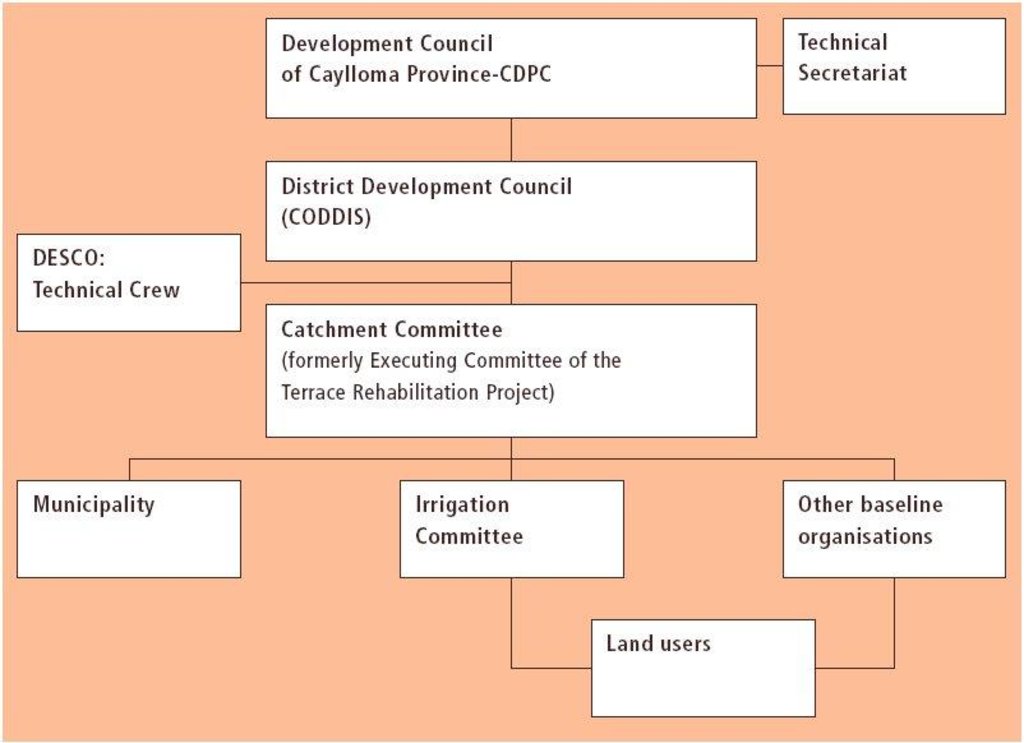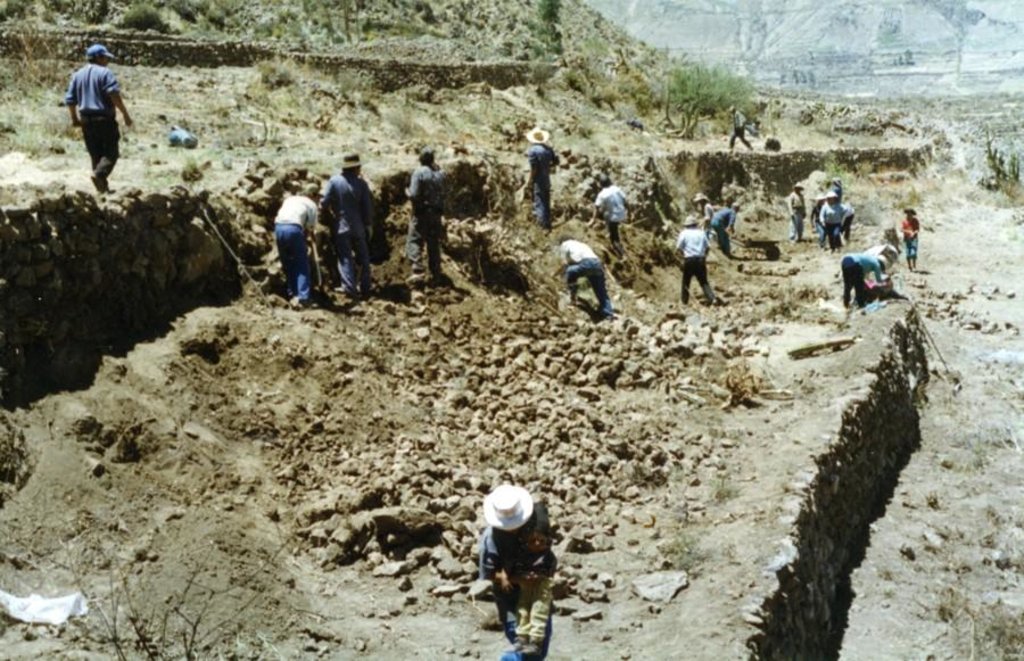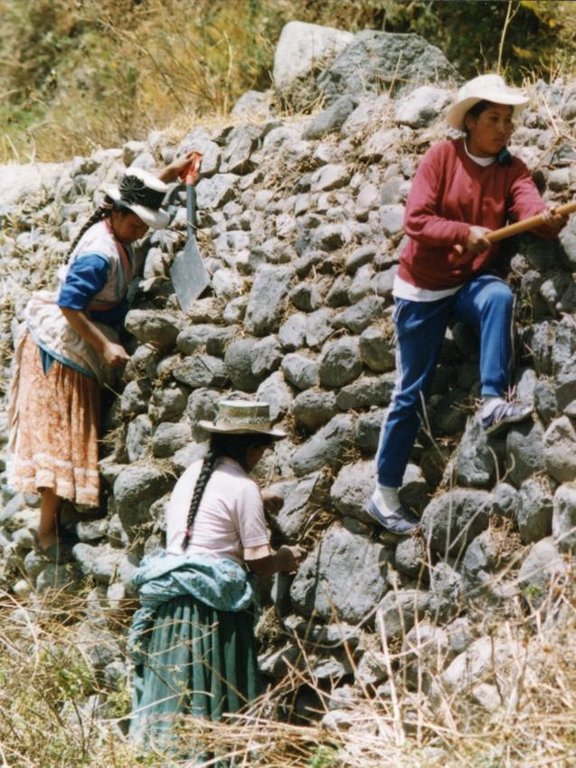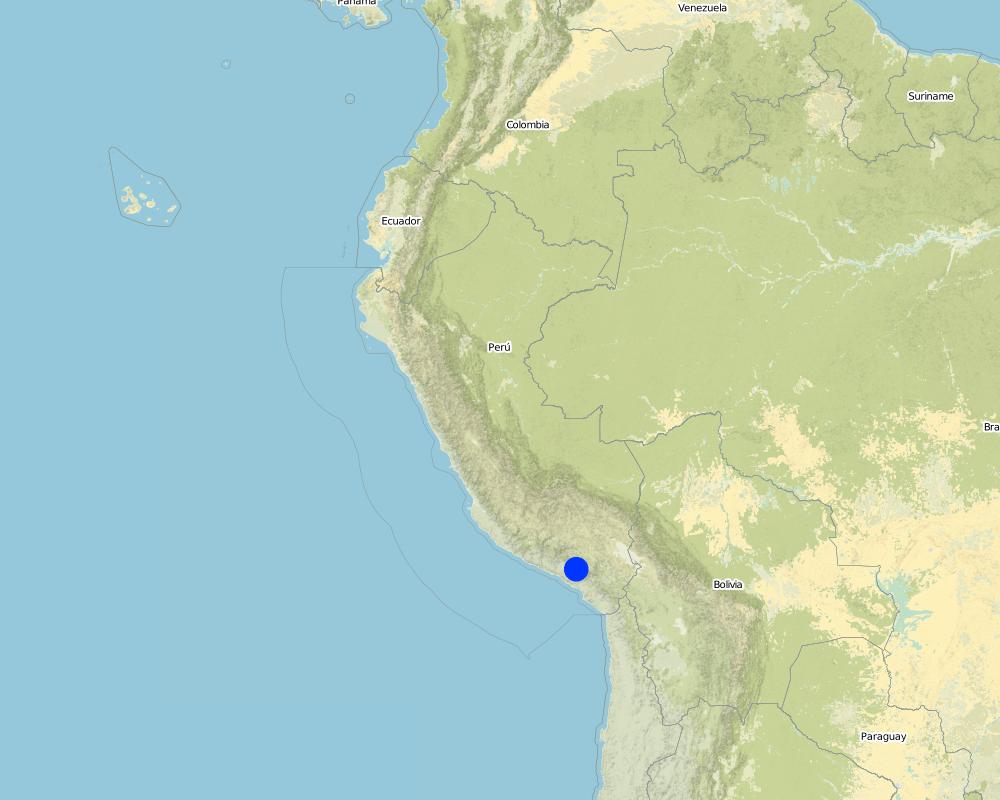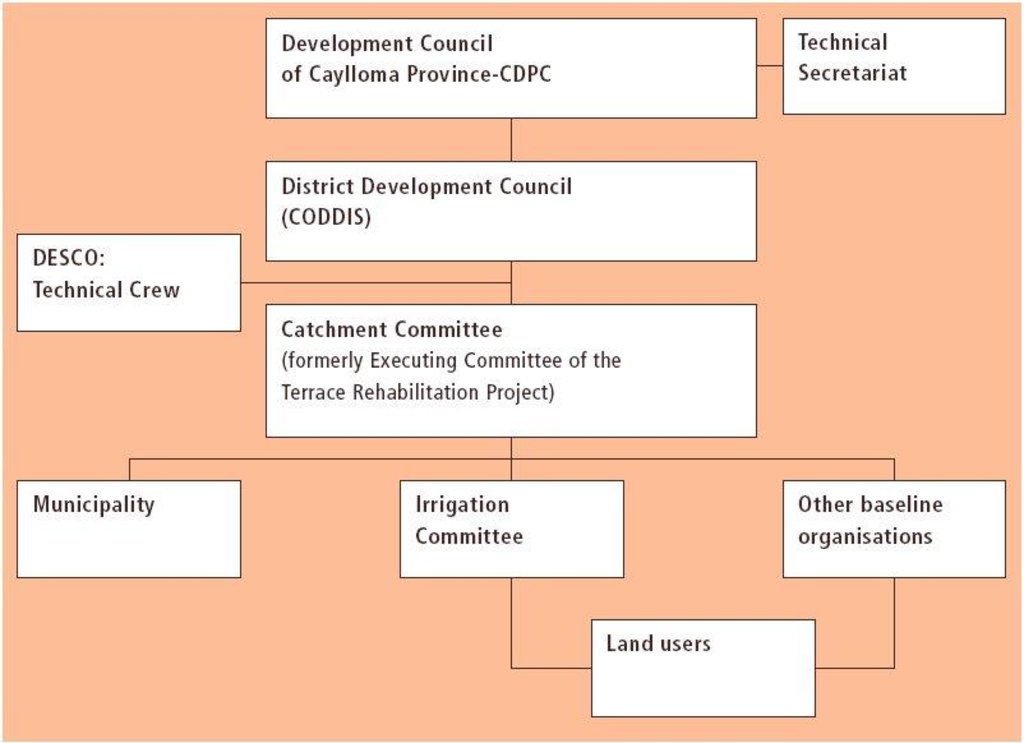Participatory catchment rehabilitation (Participación comunitaria para la rehabilitación de cuencas) [秘鲁]
- 创建:
- 更新:
- 编制者: Philippe Zahner
- 编辑者: –
- 审查者: Fabian Ottiger, Deborah Niggli
approaches_2347 - 秘鲁
查看章节
全部展开 全部收起1. 一般信息
1.2 参与方法评估和文件编制的资源人员和机构的联系方式
SLM专业人员:
Marquina Rodolfo
descolca@terra.com.pe
Centro de Estudios y Promocion del Desarrollo - DESCO
Calle Malaga Grenet No. 678 Umacollo, Arequipa
秘鲁
SLM专业人员:
Marcacuzco Aquilino P Mejia
Centro de Estudios y Promocion del Desarrollo - DESCO
Calle Malaga Grenet No. 678 Umacollo, Arequipa
秘鲁
有助于对方法进行记录/评估的项目名称(如相关)
Book project: where the land is greener - Case Studies and Analysis of Soil and Water Conservation Initiatives Worldwide (where the land is greener)有助于对方法进行记录/评估的机构名称(如相关)
Swiss Agency for Development and Cooperation (DEZA / COSUDE / DDC / SDC) - 瑞士有助于对方法进行记录/评估的机构名称(如相关)
Centro de Estudios y Promoción del Desarrollo (DESCO) - 秘鲁1.3 关于使用通过WOCAT记录的数据的条件
编制者和关键资源人员接受有关使用通过WOCAT记录数据的条件。:
是
1.4 SLM技术问卷的参考
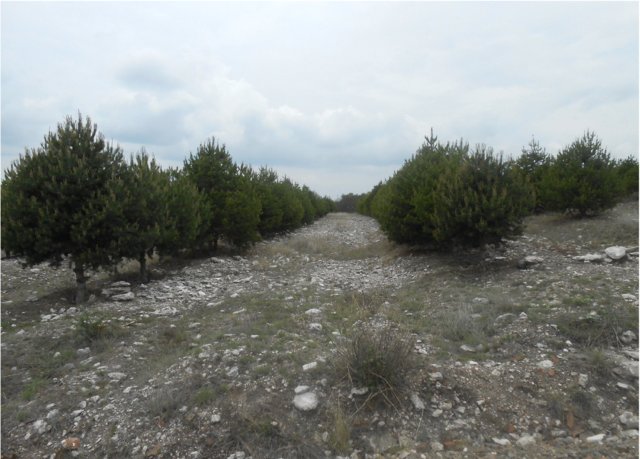
Callejones de piñón con forrajes intercalados [墨西哥]
La tecnología consiste en un sistema agrosilvopastoril con árboles de Pinus cembroides (pino piñonero) alineados een bordos ─en un terreno con suelos calizos previamente subsoleado─ conformando melgas (callejones) para con cultivos anuales para grano y forraje, con pastoreo libre eventual por períodos muy breves.
- 编制者: BENJAMIN SANCHEZ BERNAL
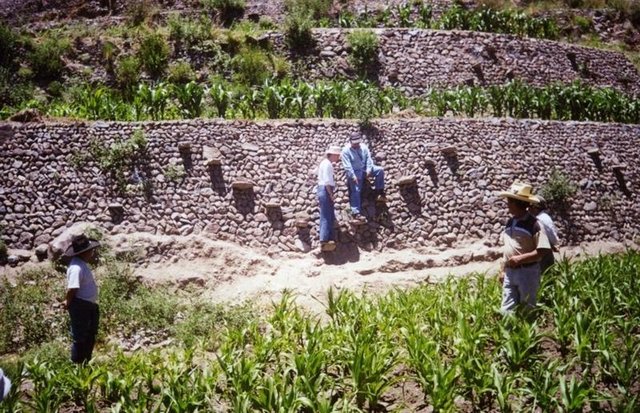
Rehabilitation of ancient terraces [秘鲁]
Repair of ancient stone wall bench terraces, and of an associated irrigation and drainage system.
- 编制者: Unknown User
2. SLM方法的描述
2.1 该方法的简要说明
Promoting the rehabilitation of ancient terrace systems based on a systematic watershed management approach.
2.2 该方法的详细说明
该方法的详细说明:
Aims / objectives: The Center for Studies and Promotion of Development - DESCO, a Peruvian NGO, started the Terrace Rehabilitation Project in 1993 to re-establish ancient terracing and irrigation practices that had largely been lost. The project is part of a general integrated development programme. Its overall purpose is to restore the productive capacity of terraced cropland, and to generate better living standards in the Colca valley. The project has the following specific objectives: (1) to increase the productive infrastructure through soil conservation and better use and management of existing water resources; (2) to increase levels of production; (3) to stimulate people in soil conservation and land management; and (4) to encourage/promote relevant local institutions. For implementation, a systematic watershed management approach was introduced. The catchment was considered the basic unit for development planning. Physical and socio-economic baseline studies were carried out. A strong community-based organisation, the catchment committee, was then founded. This consisted of representatives of major local grassroots organisations (irrigation committee, farmers' community, mothers' club etc). Responsibilities, commitments and rules were defined. Committee meetings and land user assemblies were the entities for planning, organisation and execution of project activities. DESCO initiated a process of 'concerted planning' in collaboration with other private and public institutions in Caylloma province.
Methods: In summary the project stages comprised: (1) project planning; (2) baseline studies; (3) catchment management plan; (4) constitution of the executive committee; (5) concerted planning of district development; and (6) organisation, execution, technical assistance and follow-up activities. Land users were required to participate in training courses and in fieldwork, to provide local materials and their own tools, and to fulfil duties within the organisations. Leaders and directors of grassroots organisations were responsible for planning and organisation of activities - implementation, training and follow-up - and for control and administration of project materials and inputs. The directors were also elected as representatives in the District Development Councils to participate in the evaluation and monitoring activities of the project.
2.3 该方法的照片
2.5 采用该方法的国家/地区/地点
国家:
秘鲁
区域/州/省:
Rio Colca
有关地点的进一步说明:
Arequipa, Peru
Map
×2.6 该方法的开始和终止日期
注明开始年份:
1993
2.7 方法的类型
- 基于项目/方案
2.8 该方法的主要目的/目标
- to achieve higher levels of agricultural production and productivity through integrated development/management of soil and water resources. - to build capacity for planning, organisation and implementation of development activities
The SLM Approach addressed the following problems: - lack of employment opportunities/depopulation of rural areas. - lack of planning and action in 'concerted development' - little value associated with terrace rehabilitation. - low and unequal participation of women in field work. - general impoverishment of land users
2.9 推动或妨碍实施本办法所适用的技术的条件
社会/文化/宗教规范和价值观
- 阻碍
Women were treated unequally in terms of opportunities and salaries
Treatment through the SLM Approach: Equal treatment in salaries and better opportunities were ensured for women.
财务资源和服务的可用性/可得性
- 阻碍
The poorest land users lacked the money to invest in terrace rehabilitation.
Treatment through the SLM Approach: Manual labour and tools were subsidised.
机构设置
- 阻碍
Coordination of planning and activities was lacking between different institutions and projects.
Treatment through the SLM Approach: District Development Councils (CODDIS) were strengthened as entities for coordination and concerted action.
法律框架(土地使用权、土地和水使用权)
- 阻碍
There was a lack of legal (registered) institutions to coordinate planning and strategies for sustainable land use at community level.
Treatment through the SLM Approach: An active effort was made to promote legalisation of, and give support to, grassroots organisations (eg Union of Land Users).
了解SLM,获得技术支持
- 阻碍
Local specialists in terrace rehabilitation and for construction supervision were lacking.
Treatment through the SLM Approach: Training and competitions were organised to develop skills and select the best.
其他
- 阻碍
Economical: Investment in cash crops was a problem for poor smallholders.
Treatment through the SLM Approach: Training/technical assistance was given for more profitable crops e.g potatoes, beans and peas.
3. 相关利益相关者的参与和角色
3.1 该方法涉及的利益相关者及其职责
- 当地土地使用者/当地社区
There were no differences in terms of salaries, but there were in terms of job opportunities: in a working group of 20 persons, typically only 5 women were contracted as terrace rehabilitation is very heavy work.
- SLM专家/农业顾问
- 教师/学龄儿童/学生
- 国家政府(规划者、决策者)
3.2 当地土地使用者/当地社区参与该方法的不同阶段
| 当地土地使用者/当地社区的参与 | 指定参与人员并描述活动 | |
|---|---|---|
| 启动/动机 | 互动 | interviews/questionnaires, workshops/seminars, public meetings |
| 计划 | 自我动员 | workshops/seminars; assemblies for decision making, workshops for local concerted planning |
| 实施 | 互动 | casual labour, responsibility for minor steps; casual labour, responsibility for minor steps (land users in general); responsibility for major steps (leaders) |
| 监测/评估 | 互动 | workshop/seminars, reporting, measurements/observations, interviews/questionnaires, public meetings; workshops, measurements/observations (directors of baseline organisations/leaders), reports (directors), interviews (directors/teachers), public meetings (land users) |
| Research | 无 | none |
3.3 流程图(如可用)
具体说明:
District Development Council (CODDIS): social organisations, public and private institutions jointly prepare economic and social development plans in a participatory manner, and under the leadership o
3.4 有关SLM技术选择的决策
具体说明谁有权决定选择要实施的技术:
- 主要是SLM专家,咨询土地使用者之后
解释:
the terraces were in an advanced stage of collapse and the local population did not have the means to reverse the process due to lack of economic resources.
Decisions on the method of implementing the SLM Technology were made by mainly by land users supported by SLM specialists. the technology is indigenous and adapted to the area. Evaluation workshops of, and activities permitting discussions on, the technology were carried out.
4. 技术支持、能力建设和知识管理
4.1 能力建设/培训
是否为土地使用者/其他利益相关者提供培训?:
是
培训形式:
- 公开会议
培训形式:
- exchange of experiences
涵盖的主题:
A training plan at three levels was drawn up, addressing the following target groups and topics: (1) Selected land users, leaders, supervisors: in-depth training on the interrelations between water, soil and plants; terrace and canal construction; institution/enterprise management; natural resource management, conservation practices, and crop production. (2) Directors of grassroots organisations
4.2 咨询服务
土地使用者有权使用咨询服务吗?:
是
说明/注释:
Key elements: technical assistance and sustained follow-up, supervision by specialised engineers, evaluation (reflection) and systematisation of gained know-how and developed practices with different stakeholders, function; testing of rehabilitated structures; Capacity for extension continuation has been built up within the catchment committee. However PRONAMACHS, a governmental SWC programme, is limited
4.3 机构强化(组织发展)
是否通过这种方法建立或加强了机构?:
- 是,非常
具体说明机构的强化或建立程度:
- 本地
具体说明支持类型:
- 财务
- 能力建设/培训
4.4 监测和评估
监测和评估是该方法的一部分吗?:
是
注释:
technical aspects were regular monitored by 0 through measurements; indicators: improved structures, results of technology tests
socio-cultural aspects were ad hoc monitored by 0 through observations; indicators: land users changing attitudes of SWC
economic / production aspects were ad hoc monitored by 0 through measurements; indicators: crop production increase
area treated aspects were regular monitored by 0 through measurements; indicators: rehabilitated area
no. of land users involved aspects were regular monitored by 0 through measurements; indicators: number of households that benefited directly
management of Approach aspects were ad hoc monitored by 0 through observations; indicators: number of catchments rehabilitated with terraces and agroforestry
There were several changes in the Approach as a result of monitoring and evaluation: There were various changes/readjustments of the approach: eg the concerted planning through the Local Development Councils was incorporated 5 years after the initiation of the project.
4.5 研究
研究是该方法的一部分吗?
是
明确话题:
- 经济/市场营销
- 技术
提供进一步的细节,并指出是谁做的研究:
Technology: research has been ongoing regarding functioning of the terrace and irrigation systems. Economy/commercialisation: research regarding agronomic production, catchment appraisals and market studies have been carried out for the main products of the area.
5. 融资和外部物质支持
5.1 该方法中SLM组成部分的年度预算
注释(例如主要的资助来源/主要捐助者):
Approach costs were met by the following donors: international non-government (International NGO): 60.0%; government (national): 20.0%; local community / land user(s) (-): 20.0%
5.2 为土地使用者提供财政/物质支援
土地使用者是否获得实施该技术的财政/物质支持?:
是
5.3 对特定投入的补贴(包括劳动力)
- 设备
| 具体说明哪些投入得到了补贴 | 程度如何 | 对补贴做出具体说明 |
|---|---|---|
| 机械 | 部分融资 | A-frames, tape measures, motor drills, wheelbarrows, shovels, picks, steel bars, sledgehammers,hoes, and compressors |
| 工具 | 部分融资 | |
- 农业
| 具体说明哪些投入得到了补贴 | 程度如何 | 对补贴做出具体说明 |
|---|---|---|
| 种子 | 充分融资 | Seedlings of tree species for establishment of the agroforestry component on terraces were produced in a project-owned nursery, and they were given free of charge to interested farmers |
如果土地使用者的劳动力是一项重要的投入,那么是不是:
- 以现金支付
注释:
60% of the labour costs were met by the project.
5.4 信用
是否根据SLM活动的方法给予信用值?:
是
对条件(利率、回报等)进行具体说明:
repayment conditions: Credit was provided by FONDESURCO to land users who participated in the rehabilitation project (for seed supply) with a lower interest rate than on the market. FONDESURCO is an NGO (of which DESCO is a member) specialised in microfinances in the rural sector..
5.5 其它激励或手段
是否有其他激励措施或工具用于促进SLM技术的实施?:
是
如果是,请具体说明:
Support was provided to existing institutions (in the form of training, organisation and financial inputs). But with the formation of a catchment committee, an important grassroots organisation was built up.
6. 影响分析和结论性陈述
6.1 方法的影响
该方法是否帮助土地使用者实施和维护SLM技术?:
- 否
- 是,很少
- 是,中等
- 是,支持力度很大
There have been great improvements: introduction of high-value crops; 100% of the area cultivable; reduction of irrigation frequency by 20% due to higher efficiency of water storage by the terraces; various other SWC benefits.
Did other land users / projects adopt the Approach?
- 否
- 是,很少
- 是,中等
- 是,支持力度很大
A few other projects have adopted the approach: eg the project of the Banco de Vivienda PRATVIR in the Coporaque area; also 'Popular Cooperation' in Ichupampa (covering just 2 ha).
6.3 方法活动的可持续性
土地使用者能否维持通过该方法实施的措施(无外部支持的情况下)?:
- 是
若是,请说明如何维持:
Land users can continue the activities without external support, using traditional systems of mutual help and new forms of local organisation (catchment committee). With increased income through integration of cash crops the maintenance of the structures can be sustained.
6.4 该方法的长处/优点
| 编制者或其他关键资源人员认为的长处/优势/机会 |
|---|
| Complementary conservation practices have been integrated into the terraces system: agroforestry, improved fallow, etc (How to sustain/ enhance this strength: Training of land users in the advantages and disadvantages of these practices.) |
| nstitutional capacity building: strengthening of organisations; increased participation (How to sustain/ enhance this strength: Continue the training of leaders.) |
| SWC training and extension activities. (How to sustain/ enhance this strength: Create spaces and mechanisms for daily practice of important cultural rituals/customs.) |
| 80% of land users have changed attitudes towards SWC, and are convinced of the benefits of terrace rehabilitation (How to sustain/ enhance this strength: SWC training and extension activities.) |
| Human capacity building: 60 specialists trained in rehabilitation technology (How to sustain/ enhance this strength: Create opportunities to ensure continuation of their work.) |
| An effective systematic watershed management approach applied at catchment level (How to sustain/ enhance this strength: Other projects/institutions should apply this approach.) |
| Soil conservation activities integrated in the plans of 'concerted development' (How to sustain/ enhance this strength: Strengthening of the Local Development Councils (CODDIS).) |
6.5 该方法的弱点/缺点以及克服它们的方法
| 编制者或其他关键资源人员认为的弱点/缺点/风险 | 如何克服它们? |
|---|---|
| Labour overload in the family | Better planning of work at the household level. |
| The approach requires the participation of all social and political stakeholders - which is practically impossible | Strengthen the Local Development Councils (CODDIS). |
| The generation of income encourages the purchase of industrialised products | More training regarding consumption of local products. |
| The economic incentives provided by the project affected the existing reciprocal relationships (eg labour exchange) | Cash for work incentives are sometimes useful to overcome labour constraints due to depopulation. |
| Small holdings and land fragmentation are constraints for cost-effective agriculture | Accelerate the process of land consolidation and entitlement. |
| Changes in leadership interrupt planned processes (of activities) | Permanent training to encourage leadership qualities. |
| Lack of a crop and irrigation plan for better water management | Elaboration and application of a plan. |
7. 参考和链接
7.1 方法/信息来源
- 实地考察、实地调查
- 与土地使用者的访谈
链接和模块
全部展开 全部收起链接

Callejones de piñón con forrajes intercalados [墨西哥]
La tecnología consiste en un sistema agrosilvopastoril con árboles de Pinus cembroides (pino piñonero) alineados een bordos ─en un terreno con suelos calizos previamente subsoleado─ conformando melgas (callejones) para con cultivos anuales para grano y forraje, con pastoreo libre eventual por períodos muy breves.
- 编制者: BENJAMIN SANCHEZ BERNAL

Rehabilitation of ancient terraces [秘鲁]
Repair of ancient stone wall bench terraces, and of an associated irrigation and drainage system.
- 编制者: Unknown User
模块
无模块




